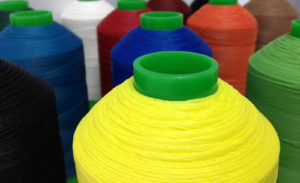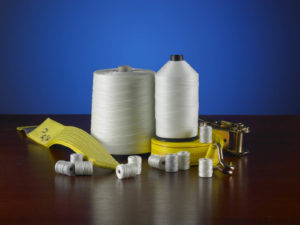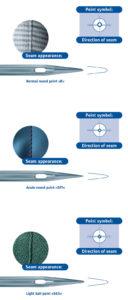
Fabricators’ needs evolve constantly, and so do the sewing threads they use.
Thread is becoming more high-tech by the day—but not necessarily in the ways you might expect. Yes, it’s being made with new synthetic fibers (although the vast majority of thread sold in the world is still cotton-poly or some subset thereof). But the real advances are in designing the thread to confer better performance characteristics or sewability.
Demand for new thread products in North America in particular is based on what fabricators here are making—basically, the sewn products that can’t practically be made overseas.
“Most of the U.S. market for thread is going to expensive fabrications such as furniture, outdoor products, leathers and bags, shoes, things like that,” says John Giordano, national sales manager at Broomfield, Colo.-based Amann Group USA, a major thread manufacturer. “From the technical end, there’s a lot of Nomex® clothing, turnout gear, that’s made in the United States. Fire gear is so expensive that it doesn’t make any sense to make it offshore. So we sell a lot of Kevlar® and Nomex® thread in the U.S.”
Giordano says regulations have led to certain other items being manufactured locally with high-tech thread. For example, a California law requiring mattresses to be sealed so they are less flammable has led to all U.S. mattresses being manufactured with a Kevlar-stitched tape band around the top edge.
A matched set
Every product a fabricator makes has its own set of requirements. Thread may be a small part of a product, percentage-wise, but it’s a critical ingredient in the product’s overall performance. Often, its content (or at least its outer surface) must match the fabric with which it is used.

With so many antimicrobial fabrics being introduced to the marketplace, antimicrobial thread was an intuitive next step for The Quality Thread & Notions Co., Solon, Ohio. The thread becomes an integral part of an overall system offering the desired characteristics. “Our product is called Guardian with Microban®,” says owner Bob Flacks. “In our minds, and in [the minds of] some customers already, they see it as completing their product. If they’re stitching any form of furniture, for example, with protective fabrics, the seam is an area that’s difficult to keep clean—it’s an area where bacteria come together. So by putting a thread there that’s antimicrobial, the bacteria are not allowed to grow as much as they would without that.”
The antimicrobial thread will be marketed for health care applications, where inhibition of bacterial growth is mission-critical. But it’s also antifungal, so Flacks envisions it being extremely useful in prolonging the lifespan of awnings and marine canvas. Without such protection, growth of bacteria, molds and mildews can cause thread to rot, dooming outdoor structures before their time.
Quality Thread’s Bob Flacks and Mike Sandercock were recently interviewed in a Marine Fabricator article in which they described the growing trend of incorporating brightly colored contrast stitching in boat seats. The same trend is happening in automobile seats and outdoor furniture, and it requires an upgrade in thread if it’s to be carried out successfully. “They’re going to be exposed extensively to the UV rays,” says Sandercock. “[There may be] cleaning chemicals that are involved, or even other chemicals, like a paint spray booth at a dealer’s painting area. You’ve got salt water that can affect them. There have been so many new developments in vinyls and fabrics that PTFE thread is pretty much a constant to go along with those.”
Flacks explains further. “If they’re going to put, for example, a bright red sewing thread on a white vinyl in a marine seat, it’s very difficult to get that done with polyester. With PTFE, we basically guarantee that the thread [color] will not migrate onto the vinyl, and also that it doesn’t lose its color over time. So the seam is going to look like new a year or two years from now, or farther down the road.”
PTFE thread has been embraced by outdoor products manufacturers because it can match or exceed the life expectancy of new long-lasting fabrics, he continues. Many fabric manufacturers offer ten-year warranties on their products, so the lifespan of the thread that is used to sew them must be at least as long.

But high-tech fibers and thread coatings aren’t necessarily better for every application. In many cases, end-product manufacturers are looking for the best-made, most optimized version of an old-school fiber. Cotton may be ancient, for example, but fabricators appreciate the way it does certain things other
fibers don’t do.
Porcupine Canvas Mfg. Ltd., Schumacher, Ont., Canada, manufactures products for a wide variety of applications and does a lot of custom work. Owner Brenda Hagerty says she uses a wide variety of threads, including high-tech versions for military and outdoor products, but cotton thread comes in handy for a few types of work in particular. “People come to us to make cases for their ice fishing huts,” she says. “We have to make sure the thread will tolerate -40°. That typically means cottons because they’re so pliable. Sometimes the old-fashioned stuff is still the best. And what’s nice is when cotton threads get wet, they swell, so they fill the stitch hole as well and no leakage happens afterward.”
Hagerty also favors cotton thread for custom wall tents for the “glamping” (glamorous camping) market, where participants are looking for an eco-friendly experience and appreciate needle holes that don’t leak in a rainstorm. In addition, she says cotton is ideal for bags used by miners. Miners always overstuff the bags, she says, so strength is at a premium. And since the bags are largely used underground, UV protection is beside the point.
The sewer’s point of view
Giordano believes many recent advances in thread have been, and will continue to be, inspired by improvements in sewing machines.
“Machines are getting faster and faster,” he says. “And a lot of machines are also computerized, which makes them go at faster speeds. So lubrication of the thread is going to be a big deal in the future.”
Why is lubrication important? “Thread is, if you think about it, like a file,” says J.R. Reyes, technical manager at Ferd. Schmetz Needle Corp. “A file goes back and forth until it basically wears out a piece of metal. The same thing happens with thread: if you mark a piece of thread where the take-up is at the top of the machine, you would see that the thread goes back and forth 60 times within the eyelets and the needle eye before it forms the stitch. That’s a lot of wear and friction and heat formation.”
Application of lubricant to thread must be a very exact science, says Leslie Bathie, vice president of technical R&D at Service Thread Mfg. Co., Laurinburg, N.C. Usually a silicone-based product, it not only smooths the thread’s path, but also helps transfer needle heat (which can otherwise exceed 300°C) away from the thread.
“You don’t want too much and you don’t want too little, because you’ve also got to be able to sew properly without any skipped stitches,” he says. “So if you don’t apply lubricant evenly, you’re going to fail. You’re going to have a lot of variance—some areas which have very little lube on it, and others that have too much. And then you have the operators complaining about misting and spraying, because some of these sewing operations are running 3,500, 4,000, 4,500 stitches a minute, and that’s fast. So you have to be wary of that, cautious, when you develop the thread itself.”

The finish on the thread can also affect the sewability in other ways, such as improving ply adhesion. “If you have a twin-needle sewing machine, typically on the left-hand needle you’d want to use an S-direction thread,” Bathie says. “But if your bond is sufficiently good, you can get by with a Z-direction in both needles because it’s not going to open up. If you don’t have a well-bonded thread on the left needle and you have a Z-twist that will open up very easily, what will happen is the hook will come around and grab one of the plies and break it.”
In general, the science of making thread—from the core to the plies to the finish—has never been more important than it is right now, because technical threads present unique challenges.
“Kevlar has never been that great of a sewing thread,” Bathie says. “You may have to decrease the speed because it doesn’t throw a loop very easily. Sometimes you want a long elongation, but not too long. And also, you’ve got to look at the forces. If you look at a high-speed photograph of a thread loop being formed, going through the fabric, you’d be amazed—if you don’t have the right properties in that area, it will not form a consistent loop. Then the hook will miss it periodically and you’ll skip stitches.”
Similarly, Sandercock says Quality Thread has had to develop new processes to make a PTFE thread that’s not too slippery to tension consistently. That’s where a thread-maker’s experience comes into play: knowing what balance of elongation, flexibility, shape and texture will make a good sewing thread. And that’s what thread manufacturers continue to do, both with new fibers and old, as the industry’s needs and wants evolve.
Jamie Swedberg is a writer and editor based in Woodville, Ga.
 TEXTILES.ORG
TEXTILES.ORG


